Christmas in Cyprus
Christmas is always celebrated in Cyprus in a rather traditional way. It is, beyond doubt, magic, precious and the most loved holiday for both children and grownups. Cyprus shares most of the Christmas customs and traditions with Greece. Their cultures have many common points, so the Christmas traditions they have are also the same or very similar. For this reason, following you will find some supplementary activities that are not mentioned in the material for Greece. In any case, what is suggested for Greece takes place for Cyprus, too. Apart from the decoration with a Christmas tree, the story with Santa Claus and the traditional Christmas food, let’s take a look in some more customs: Apart from the Christmas tree, which is a prevailing piece for every Christmas decoration, in Cyprus (and Greece) there is also a plant which is used in houses a lot during this period and it is offered as a gift many times. The florists all have the famous red Poinsettia with beautiful ribbons ready to brighten every home and they call it Alexandrino.
Traditionally, those practicing the Greek Orthodox religion fast for 40 days before the 25th of December to cleanse their bodies and celebrate the birth of Christ. Though few maintain the tradition today, Christmas Day still marks the end of the fast and is celebrated with lots of food.
Many Cypriot traditions revolve around food. The two most popular treats of the season are melomakarona (cinnamon and orange cookies, glazed in honey syrup and covered with nuts) and kourabiedes (almond biscuits coated with icing sugar). As well as traditional sweets, on Christmas Eve women in Cyprus knead a special bread called "gennopitta“, which is known as “Christopsomo”. It is a sweet bread whose name means ‘the bread of Christ’ and typically has a cross kneaded into it. It is eaten on Christmas Day along with a huge buffet. Regarding food, there is another tradition for Epiphany Day. Housewives bake “kserotiana”, the Greek so-called “loukoumades” which is a kind of doughnut. They throw some kserotiana on the houses’ roofs so bugbears, or else “kalikantzaroi”, eat and leave.
After Mass, the village’s priest goes around the houses and sprinkle people with holy water. This custom is known as “Kalanta” and it is the ancestor of the modern version of “kalanta” (carols in Greek), sung by children today. He was accompanied by a child who held the container with the holy water. All people would throw some coins in the container, as a gift to the priest. All children went around the houses singing, in order to gain some money, known as “ploumisma” in the Cypriot dialect. Nowadays, groups of children gather and go from door to door carrying triangles and other musical instruments and singing carols on Christmas Eve. They knock on doors, asking “Na ta pume, na ta pume?” meaning “Shall we sing them?” After singing, they are rewarded either with small amounts of money or kourabiedes and melomakarona.
In some villages there is an interesting ritual where people by the fireplace make a cross in the air with an olive leaf, then make a special wish and throw it in the fire. The person throwing the branch is meant to think of someone they love; if the olive leaves crackle and jump when thrown in the fire, it means they are loved back.
The children used to get their presents on New Year's Day and not on Christmas Day, as their "Santa" is Ai-Vasilis, whom they celebrate on the 1st of January. So, on New Year's Eve, after the children had gone to sleep, the mother used to place Santa's cake with a coin inside by the Christmas tree, lighting a candle on it and placing a goblet full of wine next to it. Tradition says that Ai-Vasilis would come exhausted; he blessed the cake and drank the wine. Then he placed the presents for the children of the family under the tree. The children used to wake early in the morning and after cutting the "Vasilopitta" - Santa's cake - to find out who would be the lucky one of the year - it was the person who had the piece with the coin in it - they rushed to get their presents from under the tree.
Also, grandfathers and grandmothers used to "ploumizoun" (give money) to their grandchildren on the morning of Epiphany Day, on the 6th of January. The children, early in the morning used to go to their grandparents and said the following verse "Kalimera ke ta Phota ke tin ploumistira prota" (Good morning on this day of light and let us have our gift first). The grandparents were pleased and gave them their tip (money-gift).
Christmas in Greece
While you might be familiar with decorated trees and Rudolph, Christmas in Greece can look a little different. Here are five common traditions practiced in Greece throughout the holiday season!
Christmas Boats and Trees

Although Christmas trees are extremely popular in the States, both Christmas trees and boats can be found in the villages of the Greek islands. Throughout the country’s history, Greek wives and children would decorate wooden boats to welcome their husbands and sons back from the sea, safe from harm. Today, the tradition still stands.
Children Sing Kalanta
On Christmas Eve, it’s common in Greece for children to flock from home to home in their neighborhoods to sing Greek Christmas carols, or “kalanta.” It is not uncommon that the children will add some lines that wish the head of the household prosperity for the year ahead and a long life. They often bring along triangles to bang as they sing. The playing of the triangle is not necessarily in tune with the carols they sing, but is rather part of the tradition.

Other instruments, such as harmonicas or drums, may also be used. After wishing their neighbors happy holidays, the children are usually rewarded with sweets, dried fruits and small change.
Christ bread (Christopsomo)
Christopsomo (Christ bread) is a round loaf that is a staple of the Greek Christmas table. “Christopsomo dates back to the Ottoman era and still remains part of the customary festive food that are a prominent element of Greek Christmas traditions,” Karamanes explains. Though the decoration differs based on the region and is adapted to represent the households’s life and work, every Christopsomo has a cross made of dough in the centre, as well as almonds and nuts sprinkled on top to symbolise prosperity.
“By molding the dough into scenes from agricultural life (e.g. animals, farms and vineyards), housewives aimed to distinguish Christopsomo from the regular bread loaves and signify the special occasion of Christmas day. At the same time, its symbolic meaning is to bring a productive year to the household,” he adds. Christopsomo is eaten on the night of Christmas Eve.
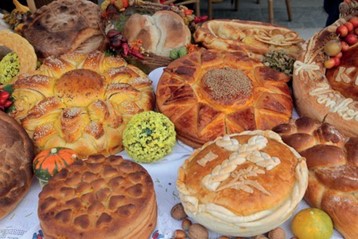
Christmas desserts
Melomakarona (honey cookies) and kourabiedes (sugar-coated butter cookies) are the most popular traditional Christmas desserts in Greece. Made solely of ingredients sourced locally, these scrumptious delicacies have, according to Karamanes, been part of Greek tradition since antiquity. “The main ingredients of melomakarona and kourabiedes are oil, honey, oranges and nuts, which are Greece’s most famous food products. Even though nowadays these honey cookies are connected with Christmas time, in ancient times Greeks were eating them as an everyday dessert” he says.
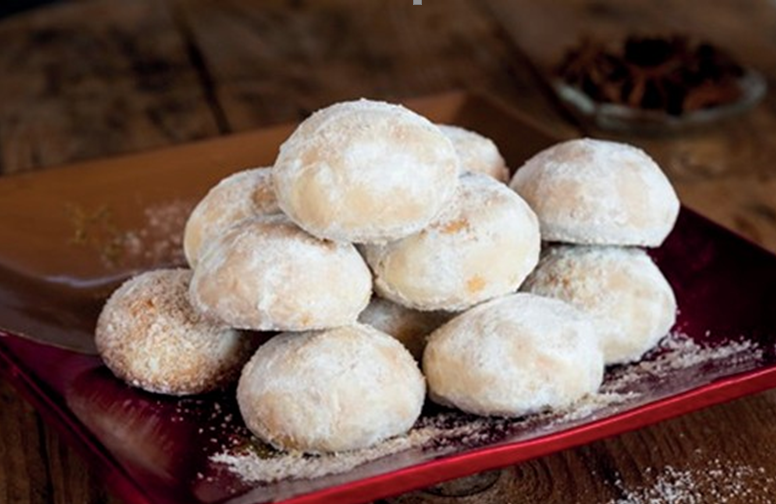
Vasilopita
Vasilopita, translating to Saint Basil’s pie, is a traditional dessert made for New Year’s Day. Every Vasilopita contains a coin; the head of the family cuts the pie into pieces, and whoever finds the coin is said to be in store for a lucky year. This tradition derives from the myth that residents of Cappadocia had collected money and jewellery to give to the area’s tyrannical prefect as a tax.
Saint Basil managed to change the prefect’s mind and exempt local people from having to give away their valuables. Not knowing how to return the possessions to their rightful owners, the residents followed Saint Basil’s advice and made small pies. Saint Basil then put the jewellery and money inside the pies and miraculously each person received their own valuables.
The Blessing of Water (Epiphany)
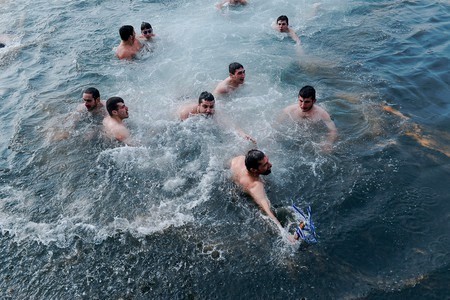
Epiphany (January 6),called Theophany and colloquially Ta Phota (meaning ‘lights’) in Greece, is a feast day celebrating the baptism of Jesus at the Jordan River by Saint John the Baptist. After the Divine Liturgy, priests carry out the water blessing. Priests throw a cross into the sea, river or lake and a group of men jump into the water to recover it. It is said that the one to find the cross first will be blessed for the whole year and that, following the ceremony, the water is totally cleansed.
Christmas in Lebanon
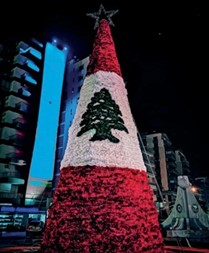
In the capital city, Beirut, big and glamorous Christmas parties are held in major hotels and lots of people like going to them, even if they're not Christian. Western-style commercial displays of poinsettias, Christmas lights, holly and community Christmas trees are also becoming more popular.
When people visit each other houses over the Christmas period, sugared almonds are often eaten with strong sweet alcoholic drink.
Other common Catholic traditions such as going to a midnight mass service are also celebrated in Lebanon.
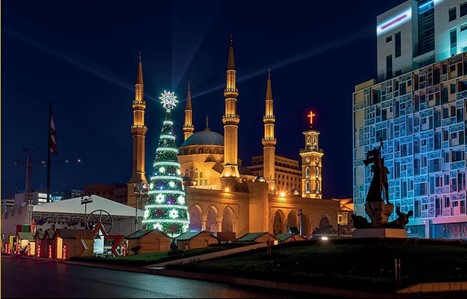

Prior to Christmas, on the night of Saint Barbara, some Christian villages also follow a special custom whereby the whole family joins together to plant seeds in a piece of cotton. Then by 24 December, the young shoots will be ready and placed in the Christmas crib as a symbol of life.
Lebanese traditions say; people plant wheat on St Barbara day as an act of sympathy with St Barbara who was hidden in a wheat field while running away from her father. Nowadays we don't just plant wheat, we do lentils, chickpeas or whatever grain that grows nicely taking advantage of it to decorate the Christmas tree.

In Lebanon, the month of December is associated with the colorful red-leafed Poinsetta plant. The Lebanese love to buy them in large quantities to decorate houses, shops and streets.
"Poinsettia is really the Christmas plant here. People like to offer them as gifts or place them around the house to give a joyful atmosphere."
In Lebanon, Santa Claus is also dressed in red and has a white fleece beard - even if the temperature is over 10°C.
When the first fairy lights and glittering stars adorn the streets and shopping markets at the beginning of December, people notice that Christmas is coming.
In Lebanon most people speak Arabic, so Merry Christmas is عيد ميلاد مجيد which means 'Glorious Birth Feast' or you could say Kul 'am wa enta bi-khair which means 'may every year find you in good health'. French is also spoken so you could wish people Joyeux Noël!
Christmas in Georgia
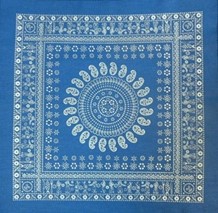
The Christmas and New Year festivities, like all festivals in Georgia, are deeply connected with table – the supra culture that here has a deeper implication than an ordinary meal has. So too, the festivity starts with spreading the table with a traditional Georgian blue table-cloth, which, with its white dye “negative” ornamental and figurative image-symbols, reflects the age-old beliefs rooted in Georgian folklore. The performance presents some of the most important ceremonies and customs that have recurred throughout centuries in every Georgian family. Some of these traditions are still kept alive nowadays.
Christmas morning in Old Georgia started with the ritual of making a wish and cracking a walnut: according to the tradition, if the walnut was a good one, the wish would come true that year. The handcrafted figure of the angel always had to be hung above the doorway, while twigs from evergreens were important attributes decorating Christmas tables.
But before that came Christmas Eve, when alilo singers (alilo – a Christmas carol, the word alilo stems from the word halleluiah) started to wander around the villages. Greeting every family and singing a carol, they knocked at house doors and asked for Christmas gifts. As preparations for the Christmas celebrations were already in progress, the families had a package filled with presents – Christmas patties, meat, eggs, churchkhelas, candies and wine – already on hand for the alilo singers.

If the wanderers passed a door without knocking, it meant that the host was known to be a miser. The post-Christmas Day festive mood lasted until New Year. During this week the neighbors visited and hosted each other until the time for preparing for the New Year celebration was fast approaching.
In old Georgia the New Year – called Kalanda – incorporated customs which reflect a peculiar mixture of ancient pagan and Christian traditions.
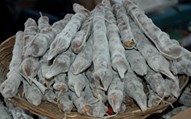
In order to bring luck and prosperity for the coming year every family throughout Georgia performed the traditional ritual on the morning of New Year’s Day. The ceremony included baking tiny breads of different shapes. Among these the most important figure was the katsabasila (the Basil man) bread figure, with dried fruit eyes and a belt with a sword. This figure occupied the central place on the New Year food platter. The Basil man was supposed to bring happiness, joy and prosperity to the family. Among other bread figures were ploughs, farming tools, axes, spindles, vines, stags, chickens, chicks and the swords, symbolizing the family’s readiness to defend the home against any enemy. These breads, called Basila breads, were made by the whole family, including the children.
Katsabasila and Basila breads together with other food and fruits were put on a New Year food platter, called Abramiant tabla (Abraham’s table) in eastern Georgia. The latter was the main attribute of the New Year ceremony performed by the family’s oldest male member: in order to bring happiness from all four corners of the earth, he lit four candles on the dish. Lifting up the dish in his hands, he walked around the house and sent his blessing loudly to the crop fields, vineyards, stable, etc., and wished prosperity and wealth to all.

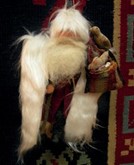
It was believed that the New Year table was a gift from a mekvle-papa – grandfather, living in the remote forests. The handcrafted figure of old man mekvle-papa was another necessary element in the house at New Year.
Among the important New Year decorations is the chichilaki. This is a wooden tree made from a hazelnut-tree stick, with hundreds of thin wooden shavings serving as branches; it is one of the main attributes of the ancient ritual connected with the New Year celebration in Georgia. Being a symbol of the Tree of Life and thus of eternal renewal and fertility, it is decorated with red berries, pomegranates and apples, and encircled by New Year candies.
The top of the tree was garlanded with a crown woven from evergreens or vine twigs. Sometimes the chichilaki was also adorned with round pies called “chicks”; these were made of egg-yolk pastry and bolkelis (tiny khachapuri). As the old Georgian New Year and St Basil’s day were both celebrated on 14 January, in folk tradition a chichilaki was also called the “St Basil’s beard.”

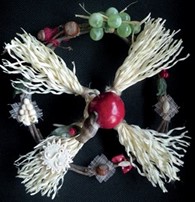
Among the age-old attributes of Georgia’s New Year celebration is the gvergvi – a crown woven out of vines with a hazelnut cross attached to it. Traditionally, the edges of the cross were adorned with pomegranates and red apples, and the crown was surrounded with evergreen twigs and red berries.

Finally, the New Year celebration ends up with a table feast, where the tamada – the toastmaster – assuming the leading role, offers different toasts in a set sequence, wishing unity to the country and happiness, joy, health and peaceful long lives to the whole family.
Christmas in Italy
Italians really feel the atmosphere since late November, but the Christmas season officially starts on December 8th, the Day of Immaculate Conception. One of the most loved traditions for Italian families is the Presepe. A Presepe, or "Presepio" as it is sometimes called (both are correct), is a Nativity scene, but there's more to it than you might expect!
On December 8th, the Feast of the Immaculate Conception, Italian Families start to build their Presepe. All the familiar characters are present - Mary, Joseph, the wise men and the shepherds - but that's just the beginning! Outside is the entire village of Bethlehem. The most important detail is of course the crib in the manger, which remains empty until Baby Jesus makes his entrance and is finally placed in the crib on Christmas Eve, completing the scene. Presepi traditionally stay out on display in Italian homes until after January 6th, the Epiphany. The tradition of Nativity Scenes dates all the way back to the 13th century. St Francis of Assisi is credited with popularizing the Presepe when, In the year 1223, St Francis built a manger in a cave in Greccio using real animals and people and celebrated Christmas Eve mass. Naples is known for creating some of the most elaborate and artful Presepi in Italy. Via San Gregorio is a street that has become famous for the craftsman that hand-carve and paint figurines from wood and terracotta. They construct Presepi of all sizes, some costing hundreds of euros.
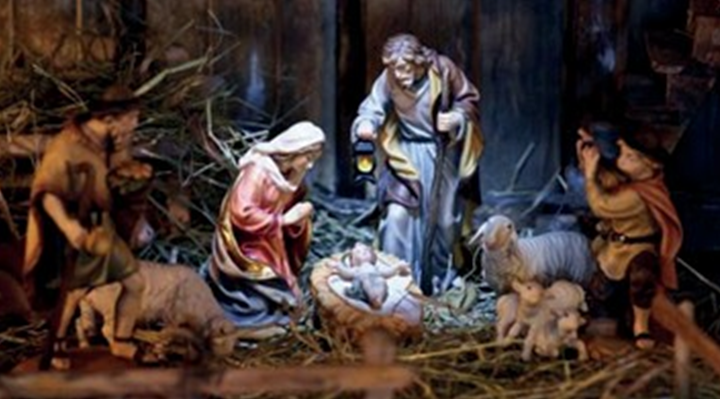
As all the cultures around the world Italians too love to celebrate Christmas around the table sharing delicious food with the beloved persons. Italian Christmas food is full of characteristic dishes that change from region to region but there are two traditional cakes that MUST be on the table of all the Italians: pandoro and panettone.
Panettone is a soft cloud of finely textured, uniform dough with a bright yellow color, filled with sultana raisins and candied fruits. When first sliced it unleashes an intense aroma of bread and citrus. This sweet’s the the result of hours, actually days, of work for the experienced hands of pastry chefs; its production is regulated with specifications establishing the amounts of all the ingredients, including sultana raisins and candied citron and orange. The dough,leavened with yeast is allowed to rise for two days and then baked. Once it is ready it is left for a whole day, then turned upside down to dry out. The origin of panettone dates back to Middle Ages, when people decided to celebrate Christmas with a bread richer than everyday bread. Eternal rival of Panettone, Pandoro is the other typical Italian Christmas cake.
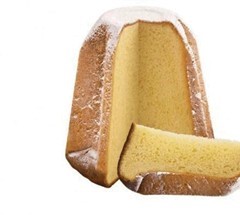
Star-shaped, covered with confectioners’ sugar, it has a soft and compact dough, a smooth consistency, and a full and velvety taste. Its origins are found in the magnificence of the Venetian court of ‘500. The making of this cake requires a double dough, alternated by long leavening times. Its softness is given by the long mixing process of the flour with the eggs that incorporates the air little by little making the mixture swollen and smooth. On the other hand, the addition of butter gives the cake its fatness, which tends to melt in the mouth. Finally, vanilla and orange or lemon zest are the essential touches to provide it with an unmistakable aroma and scent.
5 curiosities about Christmas!
1. Coca-Cola played a part in Santa's image
In 1931, Coca-Cola hired an illustrator, called Haddon Sundblom, to re-create Santa’s image. Before being in the beverage company’s ads, Santa’s look was more spooky than jolly and could cause nightmares.
2. The Dutch were the cookies and milk influencers
Thanks to the Dutch, Santa receives from kids a snack that keeps him sated on his journey. The story is that, on the 6th of December, when St. Nicholas is celebrated, children leave Santa’s a cookie and milk, as an exchange for gifts.
3. Hanging stockings were an accident
The legend of hanging stockings by the chimney started when a poor man didn’t have enough money for his three daughters’ trousseau. By knowing this, St. Nick, the generous old Santa, dropped a bag of gold down their chimney one night after the girls had hung their cleaned stockings there to dry.
4. Astronauts broadcast "Jingle Bells" from space
1965, nine days before Christmas. Two astronauts aboard the Gemini 6 told Mission Control that they saw a UFO about to enter Earth's atmosphere. When things got tense, they interrupted the broadcast with “Jingle Bells” as Wally Schirra played a small harmonica accompanied by Tom Stafford shaking a handful of small sleigh bells.
5. Santa has an address
Very nice people, with big and good hearts, working at the Canadian Post Office, started the initiative “Santa Letter-Writing Program”. Thanks to them, children now receive an answer from Santa’s Elfs. So, if you want to write Santa, here you have the address: Santa Claus, North Pole, H0H 0H0, Canada. Remember to add your address in your letter and to send it before the 10th of December.